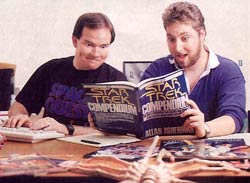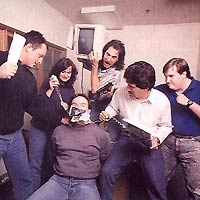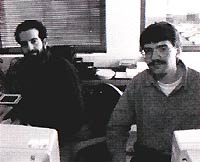Space
Quest 5 Game Information
 The
development process for Space Quest 5 began in December 1991 when
director Mark Crowe and assistant director David Selle sat down
and began roughing out the story line for The Next Mutation. It
took them about a month of conceptual work to come up with the preliminary
design and story for Space Quest 5. The
development process for Space Quest 5 began in December 1991 when
director Mark Crowe and assistant director David Selle sat down
and began roughing out the story line for The Next Mutation. It
took them about a month of conceptual work to come up with the preliminary
design and story for Space Quest 5.
The
next phase of development was to firm up the story line, flesh out
the design and draw the storyboards for the project. Technical issues
and feasibility of designer ideas were evaluated and revised with
input from both the programming and art teams. For Space quest 5,
this process stretched out over two month period, during which time
art director Shawn Sharp penciled over 200 sketches for the storyboards.
With
the storyboards under development, backgrounds for the game were
being roughed out. Nearly one hundred backgrounds and close-ups
called for in The Next Mutation. Background painter Rhonda Conley
was the in-house specialist responsible for painting the many backgrounds
sketched out by hard-working Shawn Sharp.
After
the storyboards were drawn up and the backgrounds specified, the
animation sequences were planned and a preliminary art schedule
worked out. An extensive list was drawn up for Space Quest 5 detailing
the more than 1100 loops of animations that would be called in the
finished game. Lead production artist Mike Jahnke headed up the
team of artists that undertook this formidable task.
After
the static backgrounds were painted, they were digitized and scanned
into the computer. The animation sequences were brought into the
game in two ways: some loops were hand-painted, while others were
digitized in a video capture process using live actors and a 3-chip
video camera. Production artists Jarrett Jester, Kerrie Abbott,
Ron Clayborn and Sean Murphy took these raw images and shaped them
into the animation loops and backgrounds that were incorporated
into the final game.
 About
four months into project, the final production schedule was arrived
at and the programming team fired up, led by David Sangathe. As
the artists finished artwork, the programming team went to work
combining the disparate elements of the game into a cohesive whole.
Programmers Geoff Rosser, Nancy Hamilton, Joe Nelson, and Hugh Diedrichs
faced the daunting task of brining together art, music, and story
elements within the framework of the overall game design. Space
Quest 5 was programmed using a proprietary scripting language called
SCI (short for Sierra Creative Interpreter). About
four months into project, the final production schedule was arrived
at and the programming team fired up, led by David Sangathe. As
the artists finished artwork, the programming team went to work
combining the disparate elements of the game into a cohesive whole.
Programmers Geoff Rosser, Nancy Hamilton, Joe Nelson, and Hugh Diedrichs
faced the daunting task of brining together art, music, and story
elements within the framework of the overall game design. Space
Quest 5 was programmed using a proprietary scripting language called
SCI (short for Sierra Creative Interpreter).
 Early
in the production process for the game, a sound and music specification
was drawn up by the design team and given to composers Chris Stevens
and Tim Clarke. Together, they sweated over every grunt, gasp and
groan that went into the final game soundtrack. Meanwhile, Assistant
Director David Selle shouldered the burden of writing the myriad
of text and dialogue needed for The Next Mutation. Early
in the production process for the game, a sound and music specification
was drawn up by the design team and given to composers Chris Stevens
and Tim Clarke. Together, they sweated over every grunt, gasp and
groan that went into the final game soundtrack. Meanwhile, Assistant
Director David Selle shouldered the burden of writing the myriad
of text and dialogue needed for The Next Mutation.
After
programming was completed, the game faced a four-month quality assurance
process led by Forrest Walker and Greg Giles to ensure that no bugs
or glitches remained in the shipped version of the game. This article
was reprinted from the official Space Quest 5 hint book.
The
game was originally sold for $69.99 and was included later on in
several bundles and collections. The original game came with:
- a box
- five 3.5" game disks
- Sierra game manual
- the Galactic Inquirer tabloit
- an Osborne insert about their Sierra Authorized hint books
- several other inserst, one of them a Sprint offer (figures)
- optional hint book for $9.95
- Sierra games catalogue
____
|